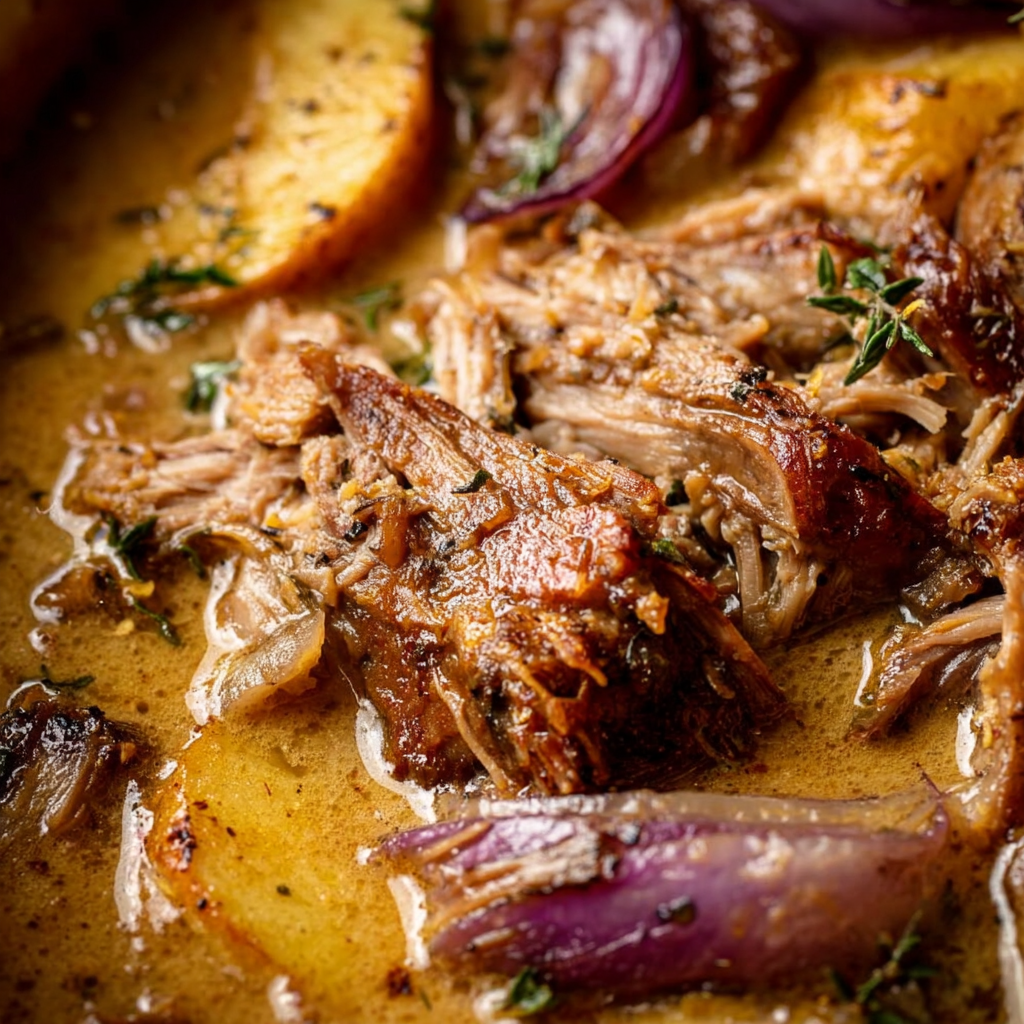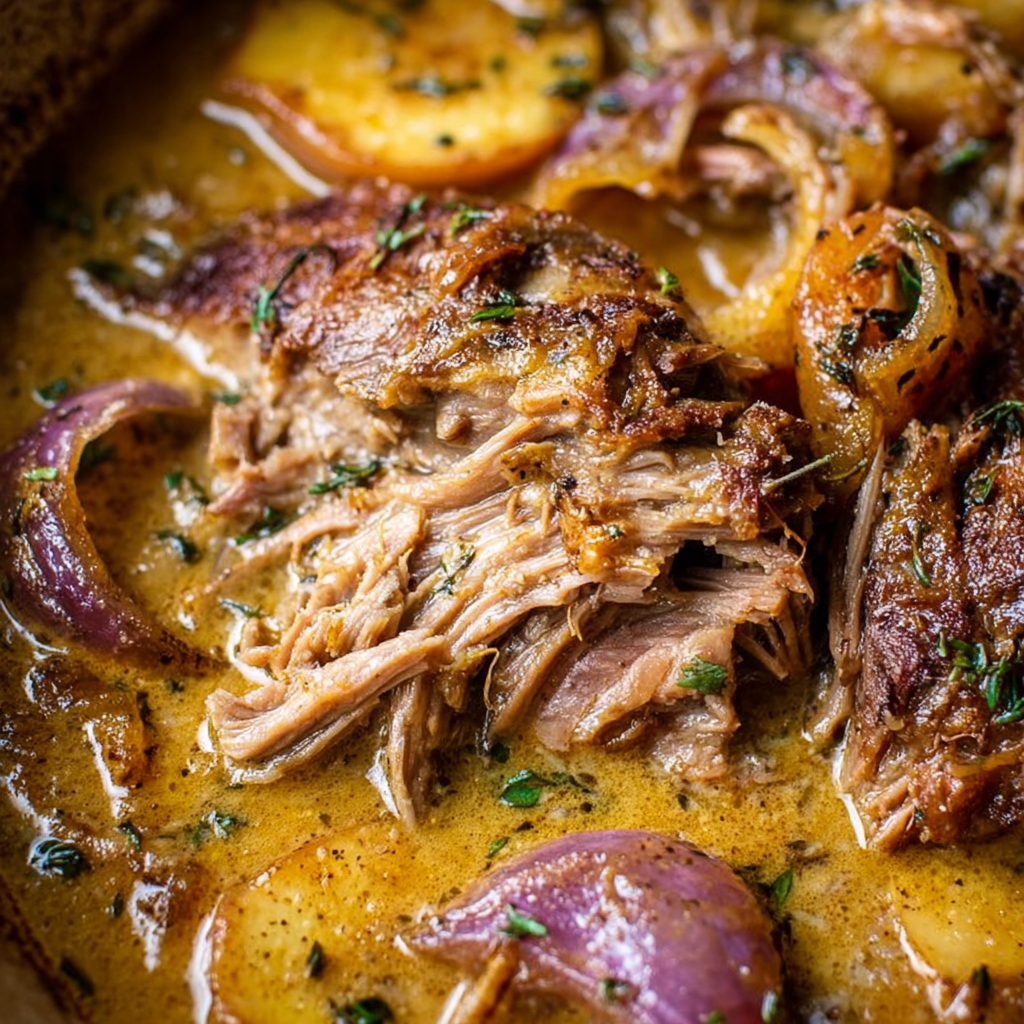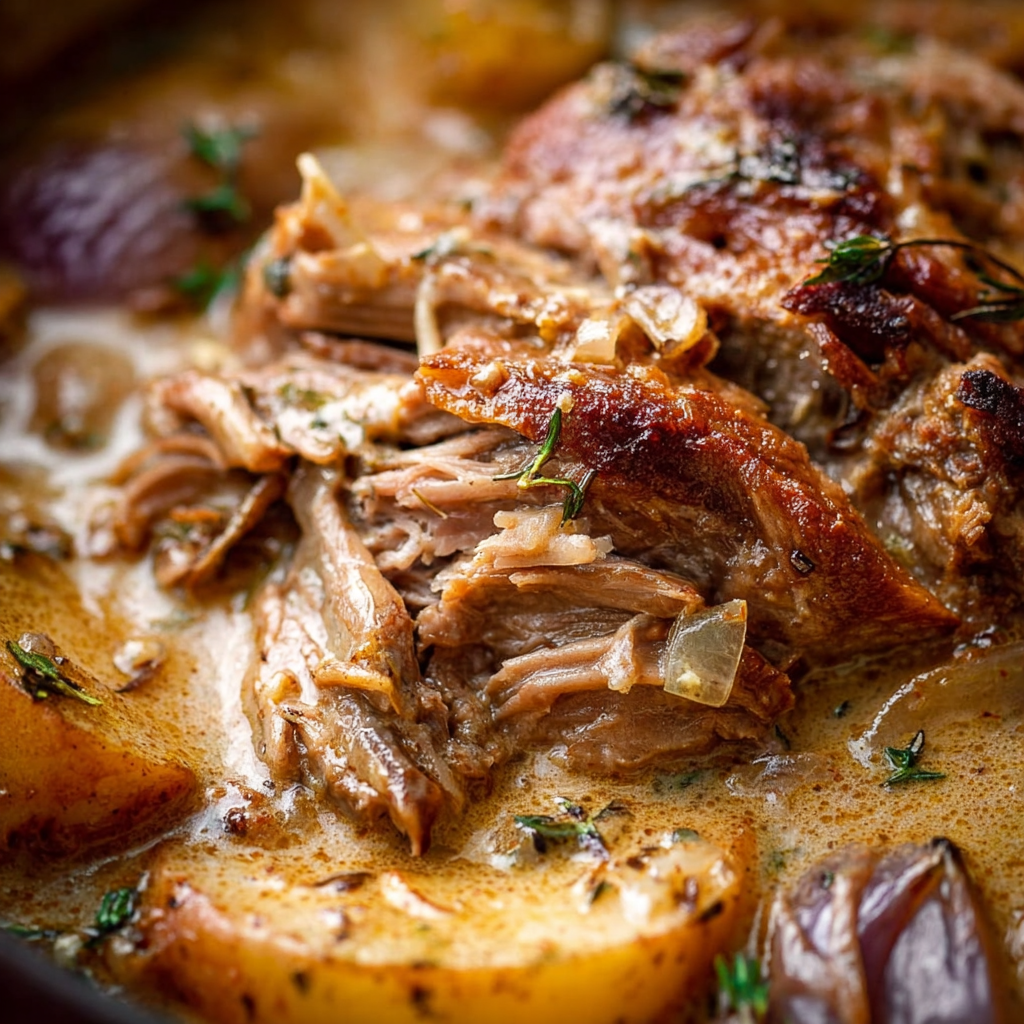Introduction
Few dishes capture the warmth of autumn quite like Apple Cider Braised Pork Shoulder. This is the kind of meal that fills your kitchen with the rich, comforting aroma of herbs, apples, and slow-roasted pork simmering away in apple cider — the culinary equivalent of a cozy sweater on a chilly day. With just a few simple ingredients, this recipe transforms an inexpensive cut of meat into something truly elegant and memorable.
Pork shoulder (also known as Boston butt) is one of those magical cuts that becomes meltingly tender when cooked low and slow. In this version, it’s seared until golden and then gently braised in a flavorful mixture of apple cider, chicken stock, Dijon mustard, and herbs. The cider lends a subtle sweetness, while the herbs and garlic infuse every bite with rustic depth. The result? A dish that’s savory, slightly sweet, and beautifully balanced.
One of my favorite parts of this recipe is how it effortlessly bridges comfort food and sophistication. It’s just as welcome at a Sunday family dinner as it is on a holiday table. The braising liquid doubles as a luscious sauce, and the apples and onions add texture and contrast to the rich pork. Serve it with mashed potatoes, roasted root vegetables, or a loaf of crusty bread to soak up every drop of the cider gravy — it’s pure autumn comfort.
If you’re a fan of slow-cooked meals that practically make themselves, you’ll love exploring Serious Eats’ braising techniques or The Kitchn’s slow-cooker collection. But first, give this Apple Cider Braised Pork Shoulder a try — it’s the kind of dish that makes you slow down, savor, and fall in love with cooking all over again.
Recipe Card
Print
Apple Cider Braised Pork Shoulder
Description
This Apple Cider Braised Pork Shoulder combines the richness of slow-cooked pork with the sweetness of apple cider, aromatic herbs, and tender apples. A comforting, crowd-pleasing fall dinner that’s as flavorful as it is beautiful.
Ingredients
- 4–5 lb pork shoulder roast or Boston butt roast*
- 2 tablespoons neutral oil (canola or vegetable oil)
- 2 cups fresh apple cider* (not apple cider vinegar)
- 2 cups chicken stock or broth
- 2 tablespoons Dijon mustard
- 1 tablespoon dehydrated minced onion
- 1 head of garlic, top sliced off (opposite of the root end)
- 3 rosemary sprigs
- 4 thyme sprigs
- 1 red onion, cut into thick slices
- 2 firm, slightly tart apples*, peeled and cut into wedges
- Kosher salt, to taste
- Freshly cracked black pepper, to taste
Notes: Fresh apple cider (not vinegar) adds depth and natural sweetness. Choose firm apples like Honeycrisp, Braeburn, or Pink Lady that hold up well during cooking.
Instructions
- Preheat and Prepare:
Preheat your oven to 325°F (163°C). Pat the pork shoulder dry with paper towels, then season generously with salt and pepper on all sides. - Sear the Pork:
In a large Dutch oven or heavy-bottomed pot, heat the oil over medium-high heat. Once hot, sear the pork shoulder on all sides until golden brown, about 4–5 minutes per side. Transfer to a plate and set aside. - Build the Base:
In the same pot, add the red onion slices and sauté for 3–4 minutes until slightly softened and beginning to brown. Stir in the Dijon mustard and dehydrated onion, scraping up any browned bits from the bottom of the pan. - Add the Liquids:
Pour in the apple cider and chicken stock, stirring well to combine. Add the garlic head (cut side up), rosemary, and thyme. Bring to a gentle simmer. - Braise the Pork:
Return the pork shoulder to the pot, nestling it into the liquid. Cover with a tight-fitting lid and transfer to the preheated oven. Braise for 2½ to 3 hours, turning the roast halfway through, until the meat is fork-tender and pulls apart easily. - Add Apples:
In the last 30 minutes of cooking, add the apple wedges around the pork. Cover and return to the oven. The apples will soften and absorb the savory cider flavor without falling apart. - Finish and Serve:
Remove the pork from the pot and let it rest for 10–15 minutes before slicing or shredding. Strain the braising liquid if desired, or simmer it on the stovetop for a few minutes to reduce and thicken into a silky sauce. Serve the pork with the apples, onions, and plenty of that luscious cider gravy spooned over the top.
Notes
Active Time: 25 minutes
Passive (Braising) Time: 3 hours
Use a Dutch oven for the best heat retention and even cooking.
Don’t rush the sear — that deep caramelized crust adds huge flavor to the finished dish.
If your cider is very sweet, balance the flavor with an extra spoonful of Dijon or a splash of apple cider vinegar at the end.
Advanced Techniques
Building a Deeper Flavor Base Before Braising
A great braise starts with great caramelization. Take your time browning the pork shoulder until it’s a deep, rich golden color — this creates the base for your sauce. Deglaze with a splash of cider or stock after searing to release the fond (those flavorful browned bits). This small step makes a huge difference in the final depth of flavor.
Using Aromatic Herbs Effectively
Fresh rosemary and thyme are classic companions to pork, but how you use them matters. Tie the sprigs together with kitchen twine to make removal easier, and crush them lightly in your hand before adding to release their oils. If you want a slightly woodier note, toss in a small bay leaf for balance.
Balancing Sweetness and Acidity
Apple cider brings a beautiful natural sweetness, but too much can overwhelm the dish. The Dijon mustard and chicken stock help temper that, but you can also add a tablespoon of apple cider vinegar or a squeeze of lemon juice at the end of cooking to brighten the sauce.
Creating a Glossy, Restaurant-Quality Sauce
Once the pork is done, reduce the braising liquid on the stovetop until it’s thick enough to coat the back of a spoon. Whisk in a tablespoon of butter for sheen and richness. You’ll end up with a glossy, beautifully flavored sauce that elevates the entire meal.
Serving for Maximum Visual Appeal
For a stunning presentation, slice the pork against the grain and fan it out on a platter surrounded by the roasted apple wedges and onions. Spoon some sauce over the top, then garnish with a few fresh thyme leaves. It’s an effortlessly elegant way to serve a rustic dish.

Storage, Shelf Life, and Maintenance Tips
Refrigerating Leftovers
Store any leftover pork and sauce in an airtight container in the fridge for up to 4 days. The flavors actually intensify overnight, making this an even better meal the next day.
Freezing for Future Meals
This dish freezes beautifully. Shred the pork and store it with some of the sauce in freezer-safe bags or containers for up to 3 months. To reheat, thaw in the fridge overnight and warm gently on the stovetop with a splash of broth.
Reheating Without Drying Out
When reheating, always do so slowly — low heat helps maintain tenderness. If using the oven, cover with foil and reheat at 300°F until warm. You can also reheat on the stovetop, adding a few spoonfuls of stock or cider to keep the meat juicy.
Using Leftovers Creatively
Leftover Apple Cider Braised Pork Shoulder makes incredible sandwiches, sliders, or even tacos. Pile it on toasted brioche buns with coleslaw, or serve over mashed sweet potatoes for an entirely new meal.
Maintaining the Sauce’s Texture
If your sauce thickens too much after storage, thin it with a bit of warm chicken stock or cider before reheating. This brings it back to its silky, pourable consistency.

Dietary Adaptations and Substitutions
Making It Gluten-Free
This recipe is naturally gluten-free as long as your mustard and stock are certified gluten-free. Always double-check labels, especially with store-bought broths.
Lower-Sodium Option
Use low-sodium chicken stock and reduce added salt slightly. The natural flavors of cider and herbs provide plenty of depth without relying heavily on salt.
Paleo or Whole30 Adaptation
Skip the Dijon if it contains sugar or wine and substitute a compliant mustard. Make sure your stock and cider have no added sweeteners. Serve the pork with roasted vegetables or cauliflower mash for a hearty, Whole30-friendly meal.
Adjusting for a Leaner Cut
If you prefer a leaner dish, you can use pork loin, but reduce the braising time to about 1½–2 hours and be careful not to overcook. Pork shoulder is still the best choice for that melt-in-your-mouth tenderness.
Making It Vegetarian-Friendly
While this is a meat-centric dish, the flavors translate beautifully into a vegetarian version using large chunks of roasted cauliflower or root vegetables braised in the same apple cider mixture. It’s a comforting, aromatic alternative for plant-based eaters.

FAQs About Apple Cider Braised Pork Shoulder
Can I Make This in a Slow Cooker?
Yes! Sear the pork and onions on the stove first, then transfer everything to a slow cooker. Cook on low for 8 hours or high for 4–5 hours until the pork is fall-apart tender.
What’s the Best Kind of Apple Cider to Use?
Use fresh, unfiltered apple cider (the kind sold refrigerated in fall). Avoid apple cider vinegar or overly sweet juices — the best cider has natural apple flavor and a touch of tartness.
Do I Need to Peel the Apples?
Peeling is optional! Peeled apples melt more into the sauce, while unpeeled apples hold their shape better. If your apples have tender skin, leaving it on adds nice color.
Can I Make It Ahead of Time?
Absolutely — in fact, it tastes even better the next day. Cook the pork completely, let it cool, and store it in the fridge with the sauce. Reheat slowly on the stovetop before serving.
How Do I Know When the Pork Is Done?
The meat should be fork-tender and easily pull apart with little resistance. For temperature accuracy, it should reach at least 195°F internally for that perfect braised texture.

Conclusion & Final Thoughts
Apple Cider Braised Pork Shoulder is one of those dishes that feels both rustic and refined — a meal that celebrates the simple, slow magic of fall cooking. The apple cider infuses every fiber of the pork with gentle sweetness, while the garlic, herbs, and Dijon add savory depth. The result is a dish that’s hearty, comforting, and wonderfully aromatic.
What I love most about this recipe is its versatility. It’s easy enough for a weekend family dinner yet elegant enough for holiday gatherings. The leftovers are just as delicious — maybe even better — because the flavors deepen as they rest. Each bite brings a blend of tender meat, tangy cider sauce, and the delicate sweetness of roasted apples and onions.
This is the kind of meal that invites everyone to linger at the table, enjoying not just the food but the feeling it brings — warmth, comfort, and connection. Once you’ve made Apple Cider Braised Pork Shoulder, it will quickly become one of your go-to fall favorites — the perfect way to celebrate the season, one slow-simmered bite at a time.
